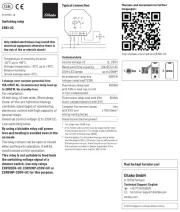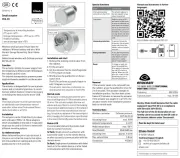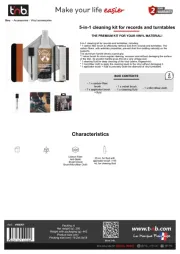Eltako FUD70S-230V-rw Handleiding
Eltako
Niet gecategoriseerd
FUD70S-230V-rw
Bekijk gratis de handleiding van Eltako FUD70S-230V-rw (2 pagina’s), behorend tot de categorie Niet gecategoriseerd. Deze gids werd als nuttig beoordeeld door 55 mensen en kreeg gemiddeld 4.7 sterren uit 28 reviews. Heb je een vraag over Eltako FUD70S-230V-rw of wil je andere gebruikers van dit product iets vragen? Stel een vraag
Pagina 1/2

Universal dimmer switch, power MOSFET
up to 400 W. Automatic lamp detection.
With adjustable minimum brightness or
maximum brightness and dimming speed.
With switching operation for light alarm
clocks, children‘s rooms and snooze
function. Also with light scene control by
PC or wireless pushbuttons. Bidirectional
wireless and with repeater function.
Only 0.6 watt standby loss.
Mounting in the 230 V power supply cord,
e.g. in false ceilings. 100 mm long,
50 mm wide and 31 mm high.
With bidirectional wireless; in addition, a
repeater function can be switched in. Every
change in state and incoming central com-
mand telegrams are conrmed by a wirel-
ess telegram. This wireless tele gram can be
taught-in in other actuators, in the GFVS
software and in FUA55 universal displays.
Universal dimmer switch for lamps up to
400 W, depending on ventilation conditions.
Dimmable energy saving lamps ESL and
dimmable 230V LED lamps, additionally
depending on the lamps electronics.
Zero passage switching with soft ON and
soft OFF to protect lamps.
The brightness level is stored on switch-off
(memory). In case of a power failure the
switch position and the brightness stage
Wireless actuator
Universal dimmer switch
FUD70S-230V as cord switch
GB
Temperature at mounting location:
-20°C up to +50°C.
Storage temperature: -25°C up to +70°C.
Relative humidity:
annual average value <75%.
30 100 852 - 1
Only skilled electricians may install this
electrical equipment otherwise there is
the risk of re or electric shock!
valid for devices from production week
14/15 (see bottom side of housing)
are stored and may be switched on when
the power supply is restored.
Automatic electronic overload protection
and overtemperature switch-off.
Function rotary switches
The left rotary switch determines the
operation, whether automatic lamp detection
or special comfort positions should work:
AUTO allows the dimming of all lamp
types.
EC1 is a comfort position for energy saving
lamps, which which by design must be
turned on with an increased voltage so that
they switch on again in cold state
EC2 is a comfort position for energy saving
lamps, which by design won’t switch on
again when dimmed down. Therefore
Memory is switched off in this position.
LC1 is a comfort position for dimmable 230 V
LED lamps which are not being dimmed
down enough when set to AUTO (trailing
phase angle) dependent on the construction
and must therefore be forced to leading
phase angle.
LC2 and LC3 are comfort positions for
dimmable 230 V LED lamps like LC1, but with
different dimming curves.
In positions EC1, EC2, LC1, LC2 and LC3
inductive (wound) transformers may not
be used. In addition, the maximum number
of dimmable LED lamps may be lower by de-
sign than in the AUTO position.
The minimum brightness (fully dimmed
down) or maximum brightness (fully
dim med up) is adjustable with the middle
% rotary switch. In the setting LRN up to
30 pushbuttons can be assigned, of which
one or more central pushbuttons.
The dimming speed is adjustable using the
right dimming speed rotary switch on the
side. At the same time, the soft ON and soft
OFF periods are changed.
The pushbuttons can be taught-in
either as direction switches or universal
switches:
When installed as a direction switch, one
side is then 'switch on and dim up' and the
other side is 'switch off and dim down'.
A double-click on the switch-on side activa-
tes automatic dim-up to full brightness at
dim speed. A double click on the switch-off
side activates the snooze function. The
children‘s room function is implemented on
the switch-on side.
As a universal switch, change the direction
by briey releasing the pushbutton. With
switching operation for children‘s rooms and
snooze function.
Switching for light alarm clocks: A wire-
less signal of a time clock which was
taught-in accordingly starts the wake up
function by switching on the light at the
lowest brightness level and dims up slowly
until the maximum level is reached.
Dependent on the set dim speed the wake
up time is between 30 and 60 minutes.
The dimming process is stopped by tapping
briey, e.g. on the hand-held transmitter.
At setting ESL the switching for light alarm
clocks is not possible.
Switching operation for children‘s rooms
(universal switch or direction switch on the
switch-on side): If the light is switched on
by holding down the pushbutton, it starts at
the lowest brightness level after approx. 1
second and dims up slowly as long as the
pushbutton is held down. The last saved
brightness level is not modied.
Snooze function (universal switch or
direction switch on the switch-off side):
With a double impulse the lighting is
dimmed down from the current dimming
position to the minimum brightness level
and switched off. The current dimming
position as well as the adjustable minimum
brightness level determine the dimming
time (max. = 60 minutes) which can be
reduced as required. It can be switched off
at any time by short-time control com-
mands during the lighting is dimmed down.
Light scenes on the PC are set and
retrieved using the Wireless Visualisation
and Control Software GFVS. A description
of the GFVS is at „eltako-wireless.com“. One
or several FUD70S devices must be taught
in on the PC as dimming switches with
percentage brightness values.
Lights scenes with wireless switches are
taught-in on the FUD. Up to four brightness
values are retrievable using a direct light
scene pushbutton (pushbutton with double
rocker, top left = light scene 1, top right =
light scene 2, bottom left = light scene 3 and
bottom right = light scene 4) and/or using a
sequential light scene pushbutton (push-
button or one half of a double pushbutton,
press top = next light scene, press bottom =
previous light scene).
If a wireless motion-brightness sensor
FBH is taught-in, the switching threshold
will be set with the right rotary switch while
teaching-in, in which, depending on the
brightness (in addition to the movement),
the lighting turns on with memory voltage
(approximately 30lux in the OFF position and
up to 300lux in the max position). If the FBH
is taught-in in the ON position, it will only be
evaluated as a motion detector. A delay of
1 minute is xed in the FBH.
If a wireless brightness sensor FHD60 is
taught-in, the switching threshold will be
set with the right rotary switch while
teaching-in, in which, depending on the
brightness, the lighting turns on or off
(approximately 0 lux in the OFF position and
up to 50 lux in the ON position). When falling
below the brightness threshold, it will be
turned on with memory value. It will be
turned off at a brightness > 200 lux.
The LED on the side behind the left rotary
switch performs during the teach-in
pro cess according to the operating
instructions. It shows wireless control com-
mands by short ickering during operation.
Technical data
Incandescent and up to 400 W
halogen
1) lamps 230 V (R)
Inductive transformers (L) up to 400 W 2)3)
Electronic transformers (C) up to 400 W 2)3)
Dimmable energy up to 400 W 5)
saving lamps ESL
Dimmable 230 V LEDs up to 400 W 5)
Max./min. temperature +50°C/-20°C 4)
at mounting location
Standby loss (activ power) 0,6 W
1) For lamps with 150 W max.
2)
Per dimmer it is only allowed to use max. 2 inductive
(wound) transformers of the same type, further-
more no-load operation on the secondary part is
not permitted. The dimmer might be destroyed.

Therefore do not permit load breaking on the
secondary part. Operation in parallel of inductive
(wound) and capacative (electronic) transformers is
not permitted!
3) When calculating the load a loss of 20% for induc-
tive (wound) transformers and a loss of 5% for
capacitive (electronic) transformers must be
considered in addition to the lamp load.
4) Affects the max. switching capacity.
5) Usually applies for dimmable energy saving lamps and
dimmable 230 V LED lamps. Due to differences in the
lamps electronics, there may be limited dimming
range, switch on and off problems dependent on the
manufacturer and a restriction on the maximum num-
ber of lamps; especially if the connected load is very
low (for 5W-LEDs). The comfort positions EC1, EC2,
LC1, LC2 and LC3 optimize the dimming range, which,
however, only gives a maximum power up to 100W. No
inductive (wound) transformers may be dimmed in
these comfort positions.
Teaching-in wireless sensors
in wireless actuators
All sensors must be taught-in in the
actuators so that they can detect and
execute commands.
Teaching-in actuator FUD70S-230V
The teach-in memory is empty on delive-
ry from the factory. If you are unsure
whether the teach-in memory contains
something or not, you must rst clear
the memory contents completely:
Set the middle rotary switch to CLR. The
LED ashes at a high rate. Within the
next 10 seconds, turn the left rotary
switch three times to the right stop (turn
clockwise) and then turn back away from
the stop. The LED stops ashing and
goes out after 2 seconds. All taught-in
sensors are cleared.
Clear individual taught-in sensors
in the same way as in the teach-in proce-
dure, except that you set the middle rotary
switch to CLR instead of LRN, and operate
the sensor. The LED previously ashing at
a high rate goes out.
Teaching-in sensors
1. Setting of the left rotary switch to the
desired teaching-in function:
AUTO = timer as wake-up light;
EC1 = teach-in 'central off';
EC2 = universal switch on/off and dim;
Universal switches must be taught-in
identically at top and bottom if the
switch is to have the same function at
top and bottom.
- ' '
.
LC1 = teach-in 'central on';
LC2 = direction switch top means
'switch on and dim up', direction
switch bottom means 'switch off and
dim down';
Direction switches are automatically
taught-in completely by pressing top
or down.
LC3 = teach in sequential light scene
pushbutton, a pushbutton or half of a
double pushbutton is assigned auto-
matically;
LC4 = teach in direct light scene push-
button, a complete pushbutton with
double rocker is assigned automati-
cally;
LC5 = teach in a PC using the Wireless
Visualisation and Control Software
GFVS. The percentage brightness can
be set there between 0 and 100 per
cent and saved. Several dimmer
switches can be linked to form a light
scene.
LC6 = direction switch bottom means
'switch on and dim up', direction
switch top means 'switch off and dim
down';
Direction switches are automatically
taught-in completely by pressing top
or bottom.
2. Set the middle rotary switch to LRN.
The LED ashes at a low rate.
3. Operate the sensor which should be
taught-in. The LED goes out.
2. Set the required brightness value using a
previously taught-in universal switch or
direction switch.
3. Within 60 seconds, this brightness value
will be stored by pressing one of the four
rocker ends of a previously taught-in light
scene pushbutton for 3-5 seconds.
4. To save other light scenes, repeat from
point 2.
Retrieving light scenes
Up to four brightness values are retrievable
using a direct light scene pushbutton
(pushbutton with double rocker, top left =
light scene 1, top right = light scene 2, bottom
left = light scene 3 and bottom right = light
scene 4) and/or using a sequential light
scene pushbutton (pushbutton or one half
of a double pushbutton, press top = next light
scene, press bottom = previous light scene).
Switching on/off repeater:
Set the middle rotary switch to LRN.
Switch on supply voltage. The repeater is
switched on or off. When the power supply is
switched on, the LED lights up for 2 seconds
= repeater off (as-delivered state) or 5 se-
conds = repeater on to indicate the state.
Teaching-in feedback of this actuator in
other actuators or GFVS software:
For turning on and off and simultaneously
transmitting of feedback the right rotary
switch has to be applied.
Teaching-in feedback of other actuators
in this actuator:
'Switch on' will be taught-in in position
'central ON‘.
'Switch off' will be taught-in in position
'central OFF'.
After teach-in the function and desired
minimum brightness or maximum bright-
ness will be set.
To teach-in further sensors, turn the
middle rotary switch briey away from
position LRN. Continue the procedure
from pos 1.
After teaching-in with the left rotary
switch set the type of load. Either set
the minimum or maximung brightness
with the middle rotary switch. Set the
dimming speed with the right rotary
switch.
Saving light scenes
Up to four brightness values can be saved
using a direct light scene pushbutton.
1. Set the left rotary switch to the required
operating mode AUTO or EC or LC.
Frequency 868.3 MHz
Transmit power max. 10 mW
Hereby, Eltako GmbH declares that the radio
equipment type FUD70S-230V is in
com pliance with Directive 2014/53/EU.
The full text of the EU declaration of
conformity is available at the following
internet address: eltako.com
Must be kept for later use!
Eltako GmbH
D-70736 Fellbach
Technical Support English:
+49 711 94350025
technical-support@eltako.de
eltako.com
12/2021 Subject to change without notice.
When an actuator is ready for
teach-in (the LED ashes at a low
rate), the very next incoming
signal is taught-in. Therefore,
make absolutely sure that you do
not activate any other sensors
during the teach-in phase.
!
Product specificaties
| Merk: | Eltako |
| Categorie: | Niet gecategoriseerd |
| Model: | FUD70S-230V-rw |
Heb je hulp nodig?
Als je hulp nodig hebt met Eltako FUD70S-230V-rw stel dan hieronder een vraag en andere gebruikers zullen je antwoorden
Handleiding Niet gecategoriseerd Eltako

14 April 2025

14 April 2025

13 Maart 2024

21 Februari 2024

21 Februari 2024

21 Februari 2024

21 Februari 2024

20 Februari 2024

20 Februari 2024

20 Februari 2024
Handleiding Niet gecategoriseerd
- Physa
- Falmec
- Ixxat
- POWRUI
- Kurgo
- Body Solid
- Inter-Tech
- Homelite
- Vicoustic
- Grendel
- DivKid
- Aqua Marina
- Rotel
- WilTec
- Perfect Christmas
Nieuwste handleidingen voor Niet gecategoriseerd

13 September 2025

13 September 2025

13 September 2025

13 September 2025

13 September 2025

13 September 2025

13 September 2025

13 September 2025

13 September 2025

13 September 2025